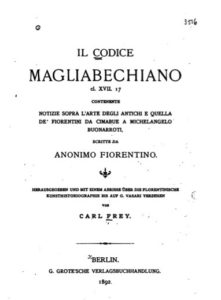
The anonymous author of the Codice Magliabechiano cl. XVII. 17 probably had close connections to the Medici court and the manuscript is the most comprehensive source for the biographies of artists in Italy before Vasari’s Vite. The manuscript has been attributed to many different authors. The author is likely to be Bernardo Veccietti (1514-1590), a Florentine humanist and art connoisseur. The manuscript belonged to the Gaddi family and, together with the codices Gaddiani, it became part of the Bibliotheca Magliabechiana. This manuscript, with 128 pages made of paper, and dating to 1540/1550, mainly focuses on Florentine artists, but the author also writes about artists from the antiquity. Vasari’s Lives contains some of the same information, but it is not clear if either Vasari or this author had consulted the other’s work. Both authors seem to have had access to a manuscript of Antonio Billi’s work from about 1515. The Codice Magliabechiano cl. XVII. 17 draws from other sources too. For the description of artists from antiquity, which makes up the first 42 pages, the author consulted Pliny’s Historia Naturalis and Eusebius’ Chronicus Canon. Cimabue’s life comes directly after the lives of the artists from antiquity. For the biographies of Trecento and Quattrocento artists, he also made use of Lorenzo Ghiberti’s I Commentarii and Christoforo Landino’s Comento sopra la Comedia di Dante Aligheri. For Giotto’s biography, he quoted from Boccacio’s Decamerone. He paraphrases his sources, combining them with his own comments. For some artists, he added an index of their followers. The manuscript is structured chronologically, is written in the vernacular, and seems to be incomplete. There are some empty pages, and it is written in a rushed and undisciplined style. The author added some notes and comments to the text and he was probably trying to complete his endeavor. But the manuscript was never printed and there are no sources indicating such a plan. Nonetheless, comments on artists working in Pisa such as Taddeo Gaddi, Bernardo di Cione, Buoanmico Buffalmacco and Antonio Veneziano make this work valuable for the study of the Camposanto, although his comments on painters in Pisa are rather brief.
Edition: Il Codice Malgliabechiano cl. XVII. 17 contenente notizie sopra l’arte degli antichi e quelle de’ Fiorentini da Cimabue a Michelangelo Buonarrati, scritte da Anonimo Fiorentino, ed. Carl Frey (Berlin: G. Grote, 1892).
14.1. Taddeo Gaddi
“E seguitò il modello del campanile di San Giovannj, dal suo maestro Giotto incominciato. A Pisa in campo santo dipinse molte storie di Job.” (55)
14.2. Bernardo [di Cione]
“In Pisa dipinse la chiesa di San Paulo a ripa d’Arno et in campo santo lo inferno.” (56)
14.3. Buonamico Buffalmacco
“In Pisa in campo santo fece detto Buffalmaccho molti lavorj. Dipinse a San Paulo a ripa d’Arno historie del testamento vecchio e molte historie di verginj.” (58)
14.4. Antonio Veneziano
“A Pisa in campo santo le storie di San Rinierj sono di sua mano.” (61)
He followed the model of the Campanile of San Giovanni, which his teacher Giotto started. He painted many stories of Job in the Camposanto in Pisa.
He painted the Church of San Paulo in Pisa on the bank of the Arno and in the Camposanto he painted Hell.
It is said that he did a lot in the Camposanto in Pisa. He painted the stories from the Old Testament and many stories of the Virgin Mary in San Paulo on the bank of the Arno.
The stories of St. Ranieri are [painted] by his hand.
